1. Movement and Locomotion
All living organisms show some type of movement. Animals, however, move more freely. It is obvious when you call your pet dog, it comes running. The same is not true of a tree. This ability to move has been used as a criterion to differentiate plants and animals. Though the movement is quite common in plants, it is not always apparent. Animals possess definite organs of locomotion.
The act of moving from place to place is known as locomotion.
It involves the movement of the whole body, as in walking, running, swimming or flying. Movement is the change in position of only a part of the body, as the movement of the stem towards the light in plants.
Need For Locomotion In Animals
- To search for food.
- To escape from enemies and predators.
- To move to a favourable environment.
- To come together for reproduction.
Why animals need locomotion?
Locomotion helps animals in many ways.
- Animals have to move from place to place in search of food since they are heterotrophic.
- Locomotion helps the animals to move in search of food.
- Locomotion enables animals to move from an unfavourable place or environment to a favourable place or environment.
- It helps them to escape from their enemies and predators.
- It helps animals to find their partners for reproduction and to move to favourable areas for egg-laying or rearing of the young ones.
2. Locomotion In Animals
In Unicellular Animals
(i) Amoeba moves about by putting forth its false feet called pseudopodia (Figure). The pseudopodia move their position every now and then, and bring about locomotion.
This type of locomotion is known as amoeboid.
(ii) Paramecium has hundreds of small fine hairs called cilia (Figure). The cilia move together just like the oars of a boat (Figure).
(iii) In Euglena a single long hair called flagellum is found. Movement takes place by the whip-like action of the flagellum (Figure).
Both cilia and flagella are locomotory organs and help in locomotion. Locomotion by cilia is called ciliary.

In Multicellular Animals
(1) Figure shows movement in a simple multicellular animal, Hydra. At its free end is the mouth. The mouth is surrounded by a number of tubular structures, called tentacles. Hydra uses its tentacles for “walking” as shown in the figure.
Movement is caused by contraction and relaxation of body cells, while locomotion is caused by looping and somersault.
(a): Looping movement in Hydra

(b): Somersault movement in Hydra

In the looping movement (Figure a), the following steps take place:
(i) Hydra bends its body and fixes its tentacles to the surface.
(ii) Then the foot releases or frees itself and is placed close to the tentacles.
(iii) Now the tentacles release their hold from the surface and the body becomes straight.
Somersault movement (Figure b) occurs as follows:
(i) The body bends till the tentacles touch the surface.
(ii) The foot releases itself from the surface and the body becomes straight. Hydra, in this situation, stands on its tentacles.
(iii) The process is repeated and the animal moves forward.
(2) (i) Earthworm has a long cylindrical body without a skeleton.
(ii) Sense organs are not present.
(iii) Circular and longitudinal muscle fibres are present on the body wall.
(iv) When the circular muscles contract, the body gets longer and narrower.
(v) When the longitudinal muscles contract, the body becomes thicker and shorter.
(vi) The movement of these muscles pushes the blood in the direction of body movement.
(vii) When it moves, the front (anterior) end becomes long and thin while its hind (posterior) end becomes short and thick (Figure). This is due to the contraction and expansion (relaxation) of body muscles. Thus, locomotion in earthworm is brought about by contraction and relaxation of body muscles.
(viii) Locomotion in leeches is also brought about in the same manner as earthworm (Figure).
Locomotion in earthworm

Locomotion in Leech

(3) In insects, two pairs of wings are usually present. Three pairs of walking appendages are also present. Both these structures help in locomotion. Invertebrate animals (fish, frogs, lizards, birds and mammals), a hard skeleton called endoskeleton is present inside the body. Endoskeleton consists of bones and cartilages. In addition, muscles are present, and these are attached to the bones. Muscles pull the bones and make them move.
Note: Some insects like the housefly and mosquito have one pair of wings.
(4) Fishes have fins and tails on their body. These help in locomotion inside the water (Figure).
(5) In frog, hind limbs with webbed feet help in locomotion (Figure).
Successive strokes for forwarding movement in fish
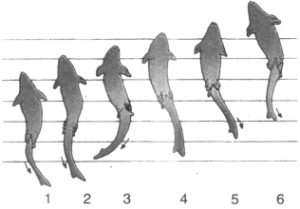
Webbed feet of a frog
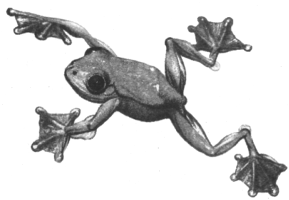
(6) In snakes, crawling movement takes place. Their bodies are covered with scales which help them to crawl.
(7) The birds use their strong breast muscles to push or pull their wings. The wings help in flying. In water birds, webbed feet are present, which help them to swim.
(8) Mammals, like tiger and elephant, use their hind limbs as well as the forelimbs for locomotion. Humans, however, use only hind-limbs for locomotion. We use our forelimbs for various other activities.
3. Movement In Humans
Locomotory movements in humans and rather all vertebrates are brought about by:
1. Bones, comprising the skeletal system (Figure A), and
2. Muscles (muscular system) (Figure B).
Functions Of Skeletal System
(i) It supports the body and gives it a definite shape.
(ii) It protects the delicate internal organs from mechanical injury. For example, the cranium (skull) protects the brain, the vertebral column protects the spinal cord and the ribs and sternum protect the heart and lungs.
(iii) It provides attachment to the muscles and helps in movement.
(iv) It produces blood cells in the bone marrow of long bones and ribs. The muscular system helps in movement and locomotion.
(A) Skeletal and (B) Muscular Systems

| Locomotion is the result of the coordinated action of muscles on the limb bones. The contraction and relaxation of muscles move the bones. Many bones of the skeleton act as levers. When muscles pull on these levers, they produce movements, such as the breathing movements of the ribs, the chewing action of the jaws and the flexing of the arms. |
Joints
The places where two or more bones meet are termed joints. In vertebrates, there are three kinds of joints:
(a) Immovable or fixed joints or fibrous joints.
(b) Slightly movable or cartilaginous joints.
(c) Freely movable or perfect joints or synovial joints.
Ligaments: The bones are held together at a joint by tough structures called ligaments.
(a) Immovable joints: These joints allow no movement. For example, the bones of the skull are interlocked with each other by their serrated margins called sutures (Figure). Joints in tooth sockets are also of this type.
(b) Slightly movable joints: In these joints, a pad of flexible cartilage is present between the bones which makes slight movements possible. Such joints are present between adjacent vertebrae in the backbone (Figure).
(c) Freely movable joints: These joints allow free movement of bones in various directions. Such joints are formed by the contact of the articular surfaces of the adjoining bones which are covered with a thin layer of cartilage. A small space is left in between the two bones. The cavity is called the joint cavity or the synovial cavity (Fig). The synovial cavity is lined with a thin synovial membrane.
Immovable joints in Human skull
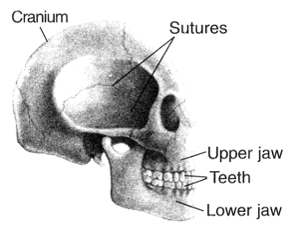
Slightly immovable joint in between vertebrae
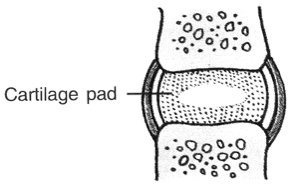
Freely movable joints are of three types:
(i) Ball and socket joint, (ii) Hinge joint, (iii) Pivot joint
All movable joints have a similar structure.
Ball and socket joint:
In this joint, the rounded head of one bone fits into a cup-shaped cavity formed by the other bone (Figure). This allows movement in all directions.
Hinge joint:
The hinge joints allow the movements only in one direction like those of a door or the lid of a box. Elbow joint (joints between the upper and the lower arm), knee-joint (between thigh and lower leg) and wrist joint (between the forearm and the wrist) are examples of this type of joint (Figure)
Section of a typical freely movable joint
(Ball and socket joint-hip)
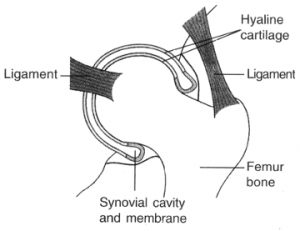
Hinge joint (elbow)

| TYPES OF JOINTS | ||
| Joint | Where found in body | Type of movement |
| Fixed | skull and pelvis | no movement |
| Slightly movable | backbone | slight movement |
| Movable (i) Ball-and-socket |
hip and shoulder | in all directions |
| (ii) Hinge | elbow, knee, finger | in only one plane – like the hinge on a door |
| (iii) Pivot | neck | nodding or turning |
Pivot joint: Such joints allow rotation only. It is because of this joint that the head is able to turn from side to side. Pivot joint occurs between the first and second vertebrae in the neck.
Muscles
(i) The muscles possess the property of contraction and relaxation. It is the property of muscles which is responsible for the movement of bones and joints.
(ii) A resting muscle is long and thin. When it contracts, it becomes short and fat.
(iii) There are three types of muscles — voluntary, involuntary and cardiac.
(iv) The movement in higher animals and humans is brought about by the voluntary muscles which are attached to the bones by means of tendons.
(v) These muscles pull on our bones when we want to move. This makes our joints bend.
(vi) The places where two or more bones meet are called joints.
(vii) Tendons are the fibres by which muscles are attached to bones. A muscle has at least one tendon at each end.
| · There are more than 350 muscles in our body.
· Muscles constitute about 40 to 50 per cent of total body weight. · Tendons attach muscles to the bones. |
Muscles and movement:
Muscles act in pairs; when one contract, the other relaxes. Bones provide leverage for rapid contraction and relaxation of the muscles.
How do our arms move?
To understand the movement, let us perform the following acts:
1) Place one of the hands-on the underside of a table with the palm facing upwards (Figure). Now try to lift the table. What happens to the muscles of the arm? Observe carefully.
You will find that when a muscle contracts, it gets shorter and fatter. When a muscle is not contracting, it returns to its normal size. In other words, it relaxes.
2) Now push down with the back of your hand against the tabletop (Figure). Observe what happens to the muscles which contract and relax.

As mentioned above, muscles work in pairs. Figure A and Figure B explain how it happens.
A. Muscles in the human arm

B. (a) Muscles when bending of arm take place;
(b) Muscles when the arm is straightened

On both sides of the upper arm bone, there is a pair of voluntary muscles. When one of these muscles contracts, it pulls the bones of the arm. This act bends or straightens the elbow joint. The muscles at the joint work in pairs -one makes the joint bend while the other makes it straight.
The biceps muscle contracts when bending of arm takes place. When it contracts, it pulls the two bones of the forearm, bringing them close together. This makes the arms bend at the hinge joint at the elbow. When the arm is straightened, the biceps muscle relaxes. The triceps muscle, however, contracts and helps in straightening.
The working together of the biceps and triceps muscles allows the arm to move in both the direction.
4. Movement In Plants
Plants are firmly rooted in the soil and have no need for locomotory organs. Movement, however, is seen in some cases.
(1) Algal forms like Chlamydomonas and Volvox show movement by means of flagella (Figure).
(2) In mosses and ferns mobility is confined to male reproductive cells. They are ciliated (movement by cilia) and move about in the water.
(3) Movement of plant parts is observed in higher plants in response to an external stimulus. These movements are slow and are not visible. The movements of plant parts which take place towards or away from the stimulus are tropisms or tropic movements (Figure).
Chlamydomonas

When the movement is towards a stimulus, it is called a positive response; and when it is away from the stimulus, it is called the negative response.
Tropic movements may be in response to light (phototropism), gravity (geotropism), water (hydrotropism) and touch (thigmotropism).
Phototropism
The movement of plants towards light is called phototropism (Photo= light; tropism= movement). Shoots generally grow towards the light (positively phototrophic), while roots away from light (negative phototrophic).
Tropic movements: Response of the stem to light and of root to gravity and water.

Geotropism
The movement in response to gravity is called geotropism (Geo= gravity; tropism= movement). Roots generally grow towards soil or gravity and are called positively geotropic. Shoots grow away from gravity (negative geotropic).
Hydrotropism
The movement of plant parts in response to water is termed hydrotropism (Hydro = water; tropism = movement). Roots are usually positively hydrotropic.
Thigmotropism
The movement of the plant in response to the stimulus of touch is called thigmotropism. It is seen in the touch-me-not (Mimosa pudica) plant. The leaflets of this plant droop on being touched and recover to the normal position after some time.
Tropic and Nastic Movements
Movements in plants may or may not be related to the direction of the stimulus. The movements in which direction of movement is always related to the direction of the stimulus are called tropic movements. For example, bending of the stem towards a light source.
Nastic movements, on the other hand, are non-directional as compared to tropic movements. The stimulus is generally diffuse, unlike tropic movements where the stimulus is localized.
Opening and closing of flowers in response to light is an example of nastic movement (photo nasty in this case).








